План – конспект урока английского языка в 5 - м классе по теме"A Trip to London"
Тема: Путешествие в Лондон.
Тип урока: урок-путешествие
Цели урока:
Социокультурный аспект:
- знакомство с достопримечательностями Лондона : Westminster Abbey, Big Ben, Tower of London, Tower Bridge, Buckingham Palace, 10 Downing Street, Trafalgar Square, London Eye, Palace of Westminster, St. Paul’s Cathedral.
Развивающий аспект:
- развитие внимания, памяти, способности к сравнению и сопоставлению речевых единиц, к анализу, обобщению;
Воспитательный аспект:
- воспитание потребности и способности к сотрудничеству и взаимопомощи при работе в паре и группе, воспитание уважительного отношения к иноязычной культуре;
Учебный аспект:
- совершенствование грамматических навыков говорения, развитие умения читать с целью полного понимания текста и с целью извлечения конкретной информации.
Задачи урока:
- познакомить учащихся с географическим положением англо-говорящих стран, достопримечательностями Лондона;
- развить умения монологической речи;
- научиться использовать новые слова по теме урока в речи;
- сформировать дружелюбное отношение к культуре и истории страны изучаемого языка;
- развить эстетическое сознание через освоение культурного наследия народов мира;
- научиться создавать обобщения и прослеживать причинно-следственные связи в истории и культуре страны изучаемого языка.
Оборудование:
Раздаточный материал;
Доска;
Презентация о достопримечательностях Лондона с элементами видеоматериала
Учебные пособия:
УМК для 5 класса Ваулина Ю.Е., Дули Д., Подоляко О.Е., Эванс В.
Ход урока
1.1 Организационный момент.
Good morning, students! Take your seats, please!
I am very glad to see you. I would like to know something about your feelings today.
Take a card, show me and say, how are you today?
Let`s talk about weather. Look through the window and tell me what the weather like today?
Remind me, please, what date is today?(Попросить записать на доске)
And what is the day of the week today?
1.2 Фонетическая зарядка (слайд 1)
[æ] – travel, capital, gallery
[ ʌ ] – come, country, love
[ju:] – museum, new, beautiful
[ı] – big, different, bridge
[α:] – park, car, partner
[i:] – see, meet, week
[eə] – square, where, hare
1.3 Мотивационная часть, беседа в форме вопрос-ответ.
Well, I`d like to ask you a few more questions:
What country do you live in?
Good! I love my country. And what about you?
What is the capital of our country?
What is the most popular place of interest in Russia?
And how about language? What language do you speak?
And what language do you learn?
OK. Well done!
And now let`s find out if you know any English-speaking countries.(слайд 2)
Look at the screen. There are some some countries. Let`s reаd it. Repeat after me.
Choose only those where people speak English.
Have you ever heard about GB?
What countries does the UK consist of? Let`s find out. (работа с картами – раздаточный материал) - слайд 3
Look at the map. What countries can you see there? Let`s pronounce their names and capitals correctly.
London`s the capital not only of England but also GB.
Have you ever been to London?
Today we`re going to make a trip to London. Let`s have a look at the screen (слайд 4), I`d like to show you a video then you should do the task.(слайд 5)
Choose the right word:
1) London is…. of Great Britain.
2) It is more than two thousand years….
3) London ….on the Thames.
4) London is one of the largest cities in the….
5) About…people live in London.
6) Now London is a…city with large squares and parks.
world
beautiful
the capital
seven million
stands
old
2. Динамическая пауза.
Are you tired? Let`s get moving.
Up-down, up-down.
Which is the way to London town?
Where, where?
Up in the air.
Open your eyes and you are there.
3. Тезариус
But before we start our traveling let's pronounce the words which will be necessary for us. Look at the screen and repeat after me.
Westminster Abbey
The Tower of London
Tower Bridge
St. Paul’s Cathedral
London Eye
Trafalgar Square
Buckingham Palace
The Thames
10 Downing Street
Westminster Bridge
Big Ben
It`s not enough to know only the names of the places of interest. Where can we get more information about them?
Работа с текстом и ответы на вопросы по тексту.
Now let’s read the texts about these places of interest in London. (работа с раздаточным материалом)
Big Ben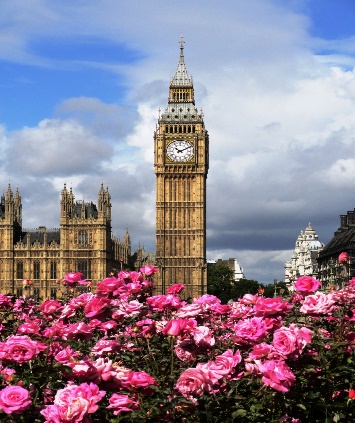
The famous clock Big Ben stands near the Houses of Parliament. Big Ben is a big bell. The clock has four faces and five big bells. The biggest bell is known as Big Ben. The bell is named after Sir Benjamin Hall; the first commissioner of works when the Houses of Parliament were rebuilt in 1850. He was a tall man, whose nickname was Big Ben. So people know the clock as Big Ben. You hear it every hour. The bell weighs 13720 kilograms. It has a deep tone and you can hear it on the radio: “This is the BBC. The time is six o’clock.” And then you hear the deep boom of Big Ben of six times.
Big Ben looks most attractively at night when the clock faces are illuminated. You even know when parliament is in session, because a light shines above the clock face.
Questions:
Where does Big Ben stand?
Who was the bell named after?
Who was Sir Benjamin hall?
Buckingham Palace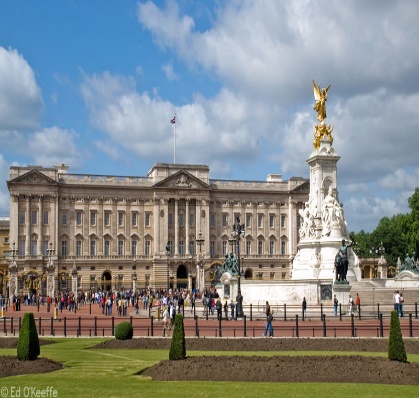
Buckingham Palace is the Queen’s official residence and is used to receive and entertain guests on state, ceremonial and official occasions for the Royal Family. The Queen has four palaces in Britain.
The Buckingham Palace is located between the Green Park, Hide Park and St. James’s Park. During August and September you can go inside Buckingham Palace. The palace is very big. You can see 19 of the rooms, ballroom and gardens, the gallery with the Royal family’s greatest treasures including paintings and the finest French and English furniture. If the Queen’s flag is flying outside the palace, it means that the Queen is at home.
Questions:
What is the Queen’s official residence?
Where is Buckingham Palace located?
When can guests go inside Buckingham Palace?
10 Downing Street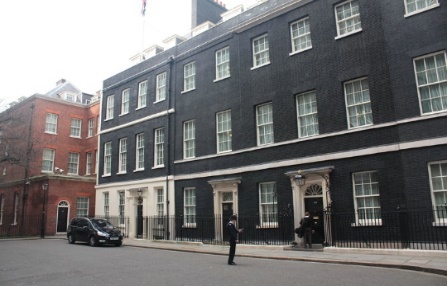
10 Downing Street is the residence and office of the Prime Minister of the United Kingdom and the headquarters of Her Majesty’s Government. Downing Street is located in Whitehall in central London, a few minutes’ walk from the Houses of Parliament and a little farther from Buckingham Palace. It is actually the official residence of the first Lord of the Treasury, but in modern times this post has always been held simultaneously with the office of Prime Minister.
Questions:
Where is Downing Street located?
Is 10 Downing Street the office of Prime Minister?
Is 10 Downing Street far from the Houses of Parliament?
What is situated next to 10 Downing Street?
4.Trafalgar Square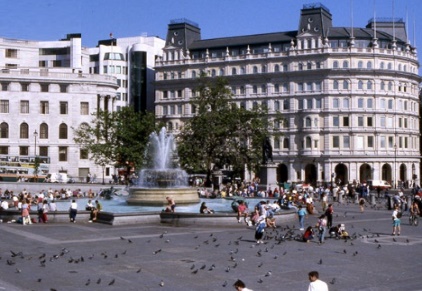
Trafalgar Square is the geographical centre of London. It was so named to commemorate Admiral Nelson’s victory at the Battle of Trafalgar. In the middle of the square there is a very famous monument Nelson’s Column with the statue of Lord Horatio Nelson on the top. The Column is over 170 feet high. Its pedestal is decorated with bas-reliefs of famous naval battles. At the base of Nelson’s Column are four great lions.
Trafalgar Square has become famous as a point for all kinds of demonstrations, marches and political meetings.
Each year in December, the people of Norway send a gift of an enormous Christmas tree to Britain which is erected in Trafalgar Square. This is thanks for Britain’s part in liberation during the Second World War.
Questions:
Why was Trafalgar Square so named?
Where is Column of Nelson situated?
What can you tell about Christmas tree in Trafalgar Square?
5. London Eye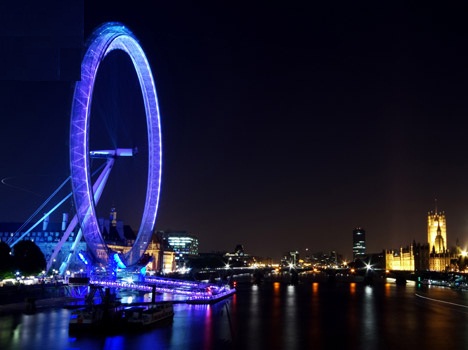
The London Eye is a giant observation wheel situated on the bank of the river Thames. It is 135 meters high. As the wheel turn it stops to allow tourists to see fantastic views over the city. It takes half an hour for the London Eye to complete one rotation.
Since opening in March 2000 the London Eye has become a symbol of modern Britain. The London Eye is visited by over 3,5 million people a year.
The wheel carries 32 sealed and air-conditioned egg-shaped passenger capsules. Each 10 tones capsule holds 25 people, who are free to walk around inside the capsule, though seating is provided.
Questions:
Where is the London Eye situated?
Since what time has the London Eye become a symbol of modern Britain?
How many tourists visit the London Eye a year?
How many passengers does the wheel carry?
6.Tower Bridge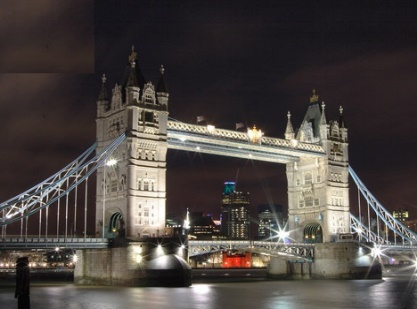
Tower Bridge is the most famous bridge over the River Thames. It is close to the Tower of London, which gives it its name. Sir John Wolfe Barry designed it.
The bridge consists of two towers which are tied together. The bridge was officially opened on 30 June 1894 by the Prince of Wales (the future King Edward VII), and his wife.
The bridge is 244 meters (800 feet) in length with two towers each 65 meters (213 feet) high.
Thousands of tourists visit Tower Bridge every year.
Questions:
What is the most famous bridge in London?
Why does it give its name?
When was Tower Bridge officially opened?
Who was Tower Bridge officially opened by?
Who designed Tower Bridge?
7.Tower of London. The White Tower.
T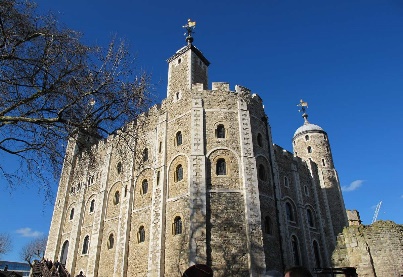 he Tower of London is one of the most imposing and popular of London’s historical sites. Now it is a museum. It comprises 20 towers. The oldest is the White Tower, dates back to the 11th century and the time of William the Conqueror. Nowadays a lot of tourists visit the Tower of London, because of the Tower’s evil reputation as a prison. The Tower has got Beefeaters, ravens, the Crown Jewels. The royal Crown has got three hundred jewels on it and the celebrated Indian diamond.
he Tower of London is one of the most imposing and popular of London’s historical sites. Now it is a museum. It comprises 20 towers. The oldest is the White Tower, dates back to the 11th century and the time of William the Conqueror. Nowadays a lot of tourists visit the Tower of London, because of the Tower’s evil reputation as a prison. The Tower has got Beefeaters, ravens, the Crown Jewels. The royal Crown has got three hundred jewels on it and the celebrated Indian diamond.
Many stories associated with British history come from the Tower in 1483 King Edward IV’s two sons were murdered in the so-called Bloody Tower. Over two centuries later the skeletons of two little boys were found buried beneath steps in the White Tower.
The ravens, huge black birds, are an official part of the Tower. Legend states that it the ravens were to leave the Tower the Crown will fall and Britain with it. Under the special care of the Raven Master, the ravens eat raw meat every day. And there is no danger of them flying away, because their wings are clipped.
Questions:
What is the most imposing and popular historical sites in London?
How many towers does the Tower of London comprise?
When was the Tower of London founded?
What is the Tower of London famous for?
8. Palace of Westminster
T he Palace of Westminster also known as the Houses of Parliament is the seat of Britain’s two parliamentary houses, the House of Lords and the House of Commons.
he Palace of Westminster also known as the Houses of Parliament is the seat of Britain’s two parliamentary houses, the House of Lords and the House of Commons.
In the middle of the 11th century, King Edward the Confessor had moved his court to the Palace of Westminster, situated on a central site near the river Thames.
In 1265 a parliament was created with two houses: the Lords and the Commons. The House of Lords met at the Palace of Westminster while the House of Commons did not have a permanent location. After King Henry VIII moved his court to Whitehall Palace in 1530, the House of Lords continued to meet in Westminster. In 1547, the House of Commons also moved here, confirming Westminster as the central seat of government, a position it still holds today.
The tower opposite Big Ben is the Victoria Tower, built in 1860. The tower contains the records of both the House of Lords and the House of Commons since 1497. During the parliamentary year the Union flag is hoisted on top of the 98m tall tower.
The Queen, who is the Head of State, opens and closes Parliament. All new laws are discussed by MPs in the Commons, then debated in the Lords, and finally signed by the Queen. All three are part of Parliament in Britain.
Questions:
Where is the seat of Britain’s two parliamentary houses?
What is opposite Big Ben?
When was the Victoria Tower built?
Who is the Head of State?
9. Westminster Bridge
W estminster Bridge is a road and foot traffic bridge over the River Thames. For over 500 years, the nearest bridge to London Bridge was at Kingston. Proposals for a bridge at Westminster had been made as early as 1664. The current bridge was designed by Thomas Page and opened in 1862. The bridge is painted green, the same colour as the leather seats in the House of Commons which is on the side of the Palace of Westminster nearest the bridge. This is in contrast to Lambeth Bridge which is red, the same colour as the seats in the House of Lords and is on the opposite side of the Houses of Parliament.
estminster Bridge is a road and foot traffic bridge over the River Thames. For over 500 years, the nearest bridge to London Bridge was at Kingston. Proposals for a bridge at Westminster had been made as early as 1664. The current bridge was designed by Thomas Page and opened in 1862. The bridge is painted green, the same colour as the leather seats in the House of Commons which is on the side of the Palace of Westminster nearest the bridge. This is in contrast to Lambeth Bridge which is red, the same colour as the seats in the House of Lords and is on the opposite side of the Houses of Parliament.
It links the Palace of Westminster on the west side of the river with Country Hall and the London Eye on the east and was the finishing point during the early years of the London Marathon.
Questions:
What colour is the bridge painted?
What does Westminster Bridge link?
11. Westminster Abbey
W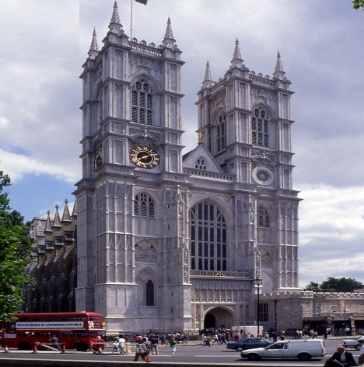 estminster Abbey is a Gothic monastery church in London that is the traditional place of coronation and burial for English monarchs. Westminster Abbey is famous for its architecture, for its historic associations. Westminster Abbey has its world famed Poet’s Corner where many of the greatest English writers are buried: Chaucer, Ch. Dickens, Tennyson, Thomas Hardy and Rudyard Kipling. Here, too, are memorials to Shakespeare, Burns, Byron, Walter Scott, Thackeray and to the great American poet Longfellow. Westminster Abbey is a place of worship owned by the royal family.
estminster Abbey is a Gothic monastery church in London that is the traditional place of coronation and burial for English monarchs. Westminster Abbey is famous for its architecture, for its historic associations. Westminster Abbey has its world famed Poet’s Corner where many of the greatest English writers are buried: Chaucer, Ch. Dickens, Tennyson, Thomas Hardy and Rudyard Kipling. Here, too, are memorials to Shakespeare, Burns, Byron, Walter Scott, Thackeray and to the great American poet Longfellow. Westminster Abbey is a place of worship owned by the royal family.
Questions:
Is Westminster Abbey a church or a palace?
What is Westminster Abbey famous for?
Who is buried in Westminster Abbey?
12. St. Paul’s Cathedral
 The city’s greatest monument, St. Paul’s Cathedral was built by Christopher Wren between 1675 and 1710. Unfortunately Christopher Wren died before the completion. He is buried there.
The city’s greatest monument, St. Paul’s Cathedral was built by Christopher Wren between 1675 and 1710. Unfortunately Christopher Wren died before the completion. He is buried there.
The Cathedral is one of Europe’s largest cathedrals and it is second in size only to St. Peter’s in Rome. The famous dome reaches a height of 111 meter (366 ft) and weights about 66,000 tons. On top of the dome is a large lantern with a weight of 850 tons.
560 steps lead visitors along three galleries all the way to the top of the dome. The first gallery, the Whispering Gallery, just inside the dome, is renowned for its acoustics. The second gallery, the Stone Gallery, is situated at a height of 53 meter (174ft) on the outside of the dome, right on top of the colonnade. On top of the dome, at a height of 85 meter (279 ft), is the narrow Golden Gallery, encircling the lantern’s base. Here you have a magnificent view over the City.
The church was the site of a number of important historic events such as the funeral of Admiral Nelson in 1806 and the funeral of Winston Churchill in 1965. Prince Charles and Lady Diana Spencer married here in 1981.
Questions:
Who built St. Paul’s Cathedral?
When was it built?
What historic events were in St. Paul’s Cathedral?
4. Now we know that there are many sights in London. Which sights of London do you know? ( дети называют достопримечательности в соответствии с карточками). What can you tell about sights of London?
(слайды 8-14)
5. Монологическая речь. Ученики рассказывают о достопримечательностях Лондона.
6. Итоги урока. Что нового узнали на уроке? Интересна ли история Лондона?
О чем бы вы хотели еще узнать?
Домашняя работа: Spotlight on Russia p.4-5. Прочитать, перевести, сделать задания к текстам.




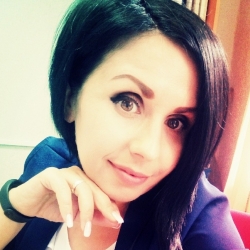








 he Tower of London is one of the most imposing and popular of London’s historical sites. Now it is a museum. It comprises 20 towers. The oldest is the White Tower, dates back to the 11th century and the time of William the Conqueror. Nowadays a lot of tourists visit the Tower of London, because of the Tower’s evil reputation as a prison. The Tower has got Beefeaters, ravens, the Crown Jewels. The royal Crown has got three hundred jewels on it and the celebrated Indian diamond.
he Tower of London is one of the most imposing and popular of London’s historical sites. Now it is a museum. It comprises 20 towers. The oldest is the White Tower, dates back to the 11th century and the time of William the Conqueror. Nowadays a lot of tourists visit the Tower of London, because of the Tower’s evil reputation as a prison. The Tower has got Beefeaters, ravens, the Crown Jewels. The royal Crown has got three hundred jewels on it and the celebrated Indian diamond. he Palace of Westminster also known as the Houses of Parliament is the seat of Britain’s two parliamentary houses, the House of Lords and the House of Commons.
he Palace of Westminster also known as the Houses of Parliament is the seat of Britain’s two parliamentary houses, the House of Lords and the House of Commons. estminster Bridge is a road and foot traffic bridge over the River Thames. For over 500 years, the nearest bridge to London Bridge was at Kingston. Proposals for a bridge at Westminster had been made as early as 1664. The current bridge was designed by Thomas Page and opened in 1862. The bridge is painted green, the same colour as the leather seats in the House of Commons which is on the side of the Palace of Westminster nearest the bridge. This is in contrast to Lambeth Bridge which is red, the same colour as the seats in the House of Lords and is on the opposite side of the Houses of Parliament.
estminster Bridge is a road and foot traffic bridge over the River Thames. For over 500 years, the nearest bridge to London Bridge was at Kingston. Proposals for a bridge at Westminster had been made as early as 1664. The current bridge was designed by Thomas Page and opened in 1862. The bridge is painted green, the same colour as the leather seats in the House of Commons which is on the side of the Palace of Westminster nearest the bridge. This is in contrast to Lambeth Bridge which is red, the same colour as the seats in the House of Lords and is on the opposite side of the Houses of Parliament. estminster Abbey is a Gothic monastery church in London that is the traditional place of coronation and burial for English monarchs. Westminster Abbey is famous for its architecture, for its historic associations. Westminster Abbey has its world famed Poet’s Corner where many of the greatest English writers are buried: Chaucer, Ch. Dickens, Tennyson, Thomas Hardy and Rudyard Kipling. Here, too, are memorials to Shakespeare, Burns, Byron, Walter Scott, Thackeray and to the great American poet Longfellow. Westminster Abbey is a place of worship owned by the royal family.
estminster Abbey is a Gothic monastery church in London that is the traditional place of coronation and burial for English monarchs. Westminster Abbey is famous for its architecture, for its historic associations. Westminster Abbey has its world famed Poet’s Corner where many of the greatest English writers are buried: Chaucer, Ch. Dickens, Tennyson, Thomas Hardy and Rudyard Kipling. Here, too, are memorials to Shakespeare, Burns, Byron, Walter Scott, Thackeray and to the great American poet Longfellow. Westminster Abbey is a place of worship owned by the royal family. The city’s greatest monument, St. Paul’s Cathedral was built by Christopher Wren between 1675 and 1710. Unfortunately Christopher Wren died before the completion. He is buried there.
The city’s greatest monument, St. Paul’s Cathedral was built by Christopher Wren between 1675 and 1710. Unfortunately Christopher Wren died before the completion. He is buried there.









